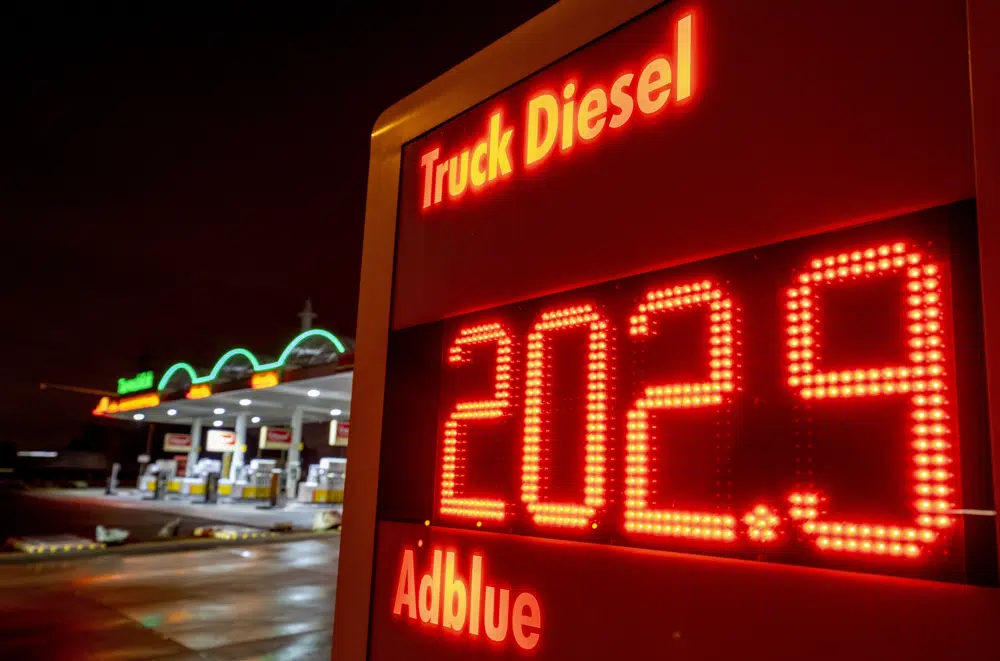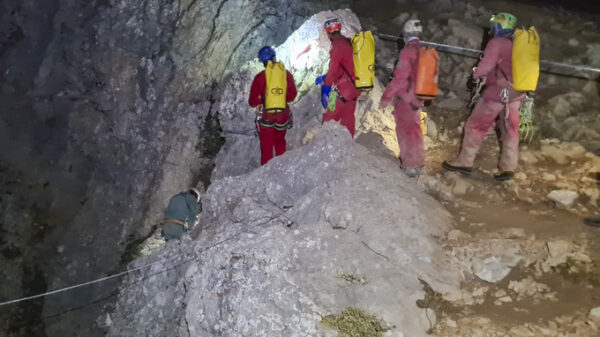The Diesel price for trucks is displayed at a gas station in Frankfurt, Germany, Friday, Jan. 27, 2023. A European ban on imports of diesel fuel and other products made from crude oil in Russian refineries takes effect Feb. 5. The goal is to stop feeding Russia’s war chest, but it’s not so simple. Diesel prices have already jumped since the war started on Feb. 24, and they could rise again. (AP Photo/Michael Probst)
FRANKFURT, Germany (AP) — Europe is taking another big step toward cutting its energy ties with Russia, banning imports of diesel fuel and other products made from crude oil in Russian refineries.
The European Union ban takes effect Feb. 5 following its embargo on coal and most oil from Russia. The 27-nation bloc is trying to sever its last uses of Russian energy and stop feeding the Kremlin’s war chest as the anniversary of the invasion of Ukraine nears.
The newest ban has risks: Diesel prices have already jumped since the war started on Feb. 24, and they could rise again for the fuel that is key to the global economy.
“We’re leaving money in the road to provide our services,” said Hans-Dieter Sedelmeier of the family-run German bus and travel company Rast Reisen.
Most things people buy or eat are transported at some point by trucks, which mostly run on diesel. It also powers farm equipment, city buses and industrial equipment. The higher cost of diesel is built into the price of almost everything, helping push up inflation that has made life harder for people worldwide.
Here are key facts about the upcoming European embargo:
WILL THE EMBARGO PUSH UP DIESEL PRICES?
That depends. Diesel, like crude oil, is sold globally, and Europe could look for new sources, such as the U.S., India or countries in the Middle East. If that goes smoothly, the impact on prices might be temporary and modest.
Europe has already cut Russian diesel imports almost in half, from 50% of total imports before the war to 27%. U.S. suppliers have stepped up shipments to record levels, from 34,000 barrels a day at the start of 2022 to 237,000 barrels per day so far in January, according to S&P Global.
The EU’s top energy official, Kadri Simson, says markets have had time to adjust after the ban was announced in June. Europeans also appear to have stocked up on Russian diesel before the deadline, with imports rising last month.
There is a complicating factor: The Group of Seven major democracies are talking about imposing a price cap on Russian diesel heading to other countries, just as they did on Russian crude. As with oil, the idea is to keep Russian diesel flowing to world markets but reduce Moscow’s revenue.
If the cap works as advertised, global diesel flows should reshuffle, with Europe finding new suppliers and Russian diesel finding new customers, without a major loss of supply.
But it’s hard to say how the cap will work without knowing where the price will be set and whether Russia will retaliate by withholding shipments.
“When Russian exports are constrained, for whatever reason, that would of course cause some trouble in this whole reshuffle process,” said Hedi Grati, head of fuels and refining research for Europe at S&P Global Commodity Insights. “Europe would be competing with other big importers, and that would cause upward pressure on pricing.”
If the cap doesn’t block large amounts of Russian diesel, there might be “a short-lived price spike” as the market adjusts. For one, tankers would have a longer journey to Europe from the U.S., Middle East or India than from Russia’s Baltic Sea ports, stressing shipping capacity.
But massive new refining capacity is launching in Kuwait and Saudi Arabia later this year and in Oman in 2024. That “could further alleviate any pressure points from this divorce from Russia,” Grati said.
WHAT COULD A DIESEL PRICE CAP ACCOMPLISH?
The hope is to reproduce the effect of the oil price cap, which barred Western companies that largely control shipping services from handling Russian crude priced above $60 a barrel.
Russia says it won’t sell oil to countries observing the price ceiling, but the cap and falling demand from a slowing global economy has meant customers in China, India and elsewhere can buy Russian oil at steep discounts, cutting into the Kremlin’s revenue.
Boosted by more expensive crude, diesel prices rose to over $1,000 a ton last week from $800 a ton in early December. Diesel costs more than $40 per barrel above the crude used to make it.
One reason for the price hike was a late December storm in the U.S. that disrupted refineries, said Barbara Lambrecht, an analyst at Commerzbank.
WHAT HAPPENS IF DIESEL GETS MORE EXPENSIVE?
Fuel prices have been a major factor behind painful inflation in Europe that has robbed consumers of purchasing power and slowed the economy.
Diesel prices at the pump have swung from 1.66 euros per liter ($6.43 a gallon) to 2.14 euros per liter ($8.29 a gallon) in the course of a year.
“That is a gigantic increase,” said Christopher Schuldes, the third generation of his family to run German trucking company Schuldes Spedition.
The company has 27 diesel trucks and 50 employees in the small town of Alsbach-Haehnlein between Frankfurt and Heidelberg in southwest Germany. It already has cut fuel costs by equipping trucks with efficient engines, ensuring trucks leave fully loaded and training employees in fuel-efficient driving.
“We did all that a long time ago, long before Russia invaded Ukraine,” Schuldes said. “There’s no more room for optimization.”
To ease the extra diesel costs, the company tried negotiating higher prices with customers who have long-term contracts. Some agreed, some didn’t. Even if a contract allows prices to rise with diesel costs, there’s a two-month lag.
Regarding the embargo, “I am of two minds about it,” Schuldes said. “I have to see that the company is in good shape, and that our purchasing is as economical as possible. On the other hand — on the personal level — I say Russia must not be supported.”
Meanwhile, Rast Reisen, the bus and travel company near Freiburg im Breisgau in southwestern Germany, has seen diesel fuel rise from 12%-15% of costs to 20%-25%. Because 15 of its 25 buses are part of the regional public transport network, the company can’t automatically raise fares, and government increases so far are “a droplet on a hot stone,” said Sedelmeier, managing director for public transport.
Rast Reisen had to add a 10- to 15-euro ($11 to $16) diesel surcharge to trips to popular destinations like northern Germany’s island of Sylt or Croatia’s coast because prices spiked after catalogues were printed. Next year, prices for trips will simply be higher.
WHAT COULD GO WRONG?
Energy markets are looking to China and wondering when the world’s second-largest economy will recover after the end of drastic COVID-19 restrictions. With low demand for fuel at home, the Chinese government let refineries ramp up their exports.
But if travel picks up in China, that diesel may disappear from the world market, raising prices as competition for fuel increases.
Copyright 2021 Associated Press. All rights reserved.
Source: https://apnews.com/article/russian-diesel-fuel-embargo-explainer-28b9043593c7cb92e032aa451c837b39










































